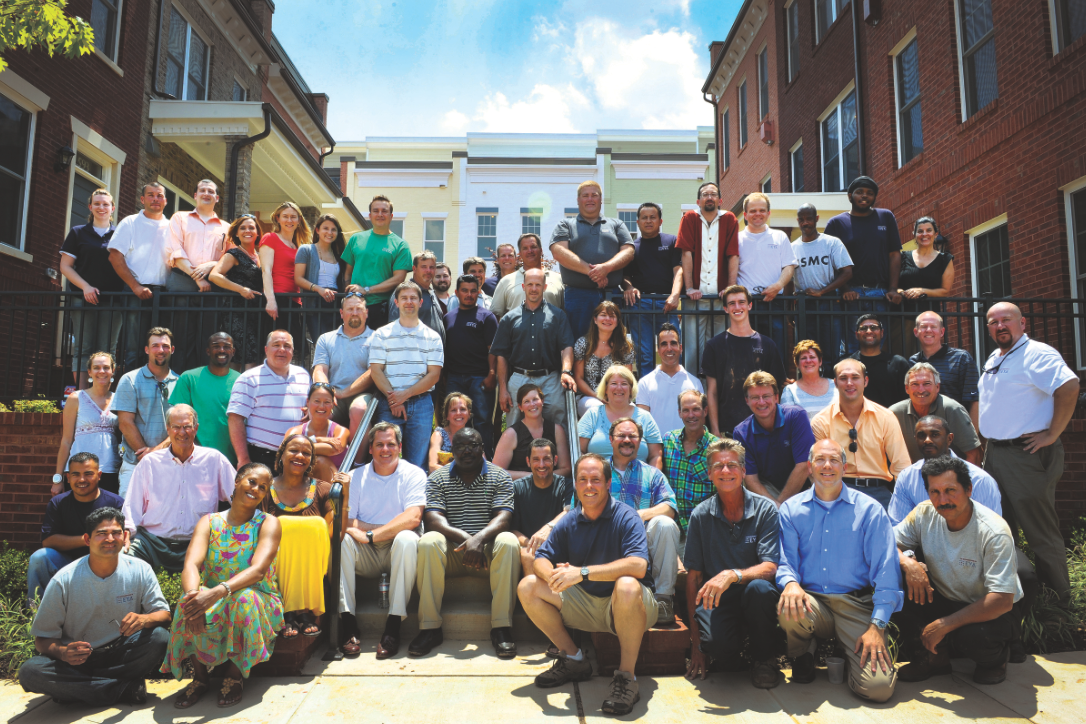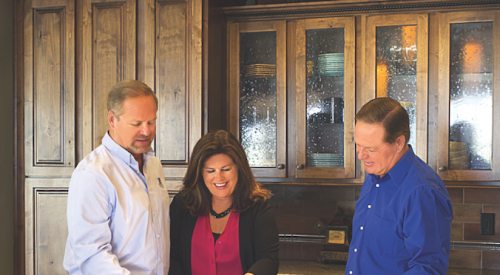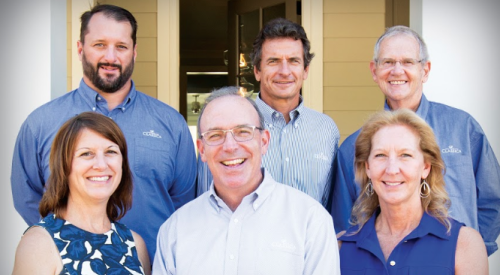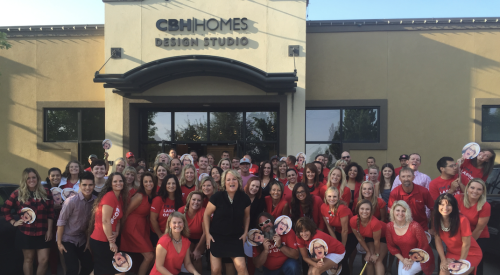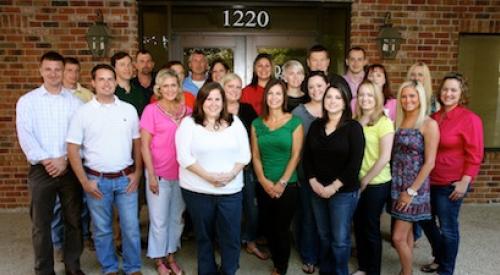What does it take to win a National Housing Quality (NHQ) Award? Plenty, but a common thread among the 2015 NHQ award recipients is that these builders emphatically seek employee participation to improve process and quality management.
Saun Sullivan, like many builders, spends most of his day out in the field walking the job site. The DSLD Homes CEO’s regular encounters with his superintendents, salespeople, and trades, though, are not just for the sake of getting updates on projects. He is also gathering his employees’ and subs’ perspectives on what the company is doing right and what it could be doing better.
Through such job site conversations, Sullivan learned that supers and warranty technicians didn’t like the amount of paper they were generating and the time consumed by shuffling documents and physically inputting the contents into the company computer. When the Denham Springs, La., builder and NHQ Award Gold winner put iPads in their hands, the tablets included a time- and process-saving document editing app that enabled the user and homeowner to complete warranty inspection forms on screen and simply email it to the company’s network.
“We don’t call meetings where we make everyone come and see us,’” Sullivan says. “Eighty percent of the time we’re out in the field, so we can see them. That puts into perspective that we’re coming to see you; we value your time, and we’ll come out there.”
EYA, another NHQ Award Gold winner and a builder of for-sale townhomes and row houses in the Washington, D.C., metro market, doesn’t include just senior management for big picture exercises in strategic planning and continuous improvement. Every year, employees create two continuous improvement objectives for their departments that fit in with the company’s annual theme, which last year was “Innovation Generation” and this year is “Sharpen the Saw,” inspired by the last chapter of Stephen Covey’s “The Seven Habits of Highly Effective People.”
Last year, EYA employees formed cross-functional teams that worked together to develop process and design improvements. Employees and department heads worked together to break down the company’s three-to-five-year and one-year strategic goals into specific objectives that were to be attained over the next six-to-eight quarters. The effort produced a single-page strategic plan that NHQ Award examiners lauded as “best in class—highly effective and pragmatic,” and they noted the strong involvement of employees in the planning process.
“Everybody ends up on the same page, which I think in many organizations is a challenge,” says Robert Youngentob, EYA co-founder, president, and CEO. “In our organization the priorities of (senior management) are the same as the department heads’ priorities, and those priorities are the same for the people who work for the department. Everyone knows how they fit into the puzzle and how their roles contribute to achieving that particular corporate goal for the year.”
In addition to team-building exercises and getaway days for company managers, NHQ Award Silver winner French Brothers, Alamogordo, N.M., hosts Fellowship Fridays. Every Friday morning, breakfast burritos are brought in and the builder’s 19 full-time employees talk about what’s happened during the past week and what’s needed to prepare for the coming week.
Employees also have quarterly checkups—“We don’t even call it a review,” says Corrine Bachman, vice president of sales and management and one of three owners with Tom and Jim French—to see how they’re doing and to discuss what the employee and management could be doing better.
The NHQ Award is the industry’s top recognition for accomplishments in total quality management. Builders apply for the distinction by answering a lengthy questionnaire about their financial results and how they run their business. A panel of experts evaluates the applications and schedules site visits for builders who demonstrate an exceptional level of performance. A team of examiners visit the finalists to review and validate the information submitted and decide whether to confer gold, silver, bronze, or honorable mention status to the winners.
DSLD Homes, Denham Springs, La.
DSLD’s Gold is the builder’s second NHQ Award; it won a Silver award in 2012. The company went on to close 1,597 homes in 2013, 43 percent more than the previous year, but Sullivan didn’t apply for NHQ last year.
“We did nothing else better than simply produce more units,” he says.
NHQ Awards judges praised DSLD employees for excelling in customer care and delight. One such outreach is emailing to customers short videos explaining which construction phase their house is entering and what will happen next. The DSLD team includes (from left): Jeff Purpera, CFO; Allen Thomason, partner; Lee Foster, COO.
FOUNDED: 2008
MARKETS: Louisiana and Harrison County, Miss.
2013 REVENUE: $299.7 million
2013 CLOSINGS: 1,597
QUALITY BEST PRACTICES
- Embracing of executive-level communication to staff
- Process-mapping 25 key processes
- DSLD’s consistent customer satisfaction results prompted Woodland, O’Brien & Scott to change its Top Performer expectations for all builders.
Sullivan learned after applying the first time years before and not even receiving a site visit that his company had a lot of work to do. So he couldn’t justify applying for a Gold award until the company addressed some of the deficiencies, 49 in all, that the examining team pointed out from the previous visit. The issues included compiling job descriptions, process maps, creating an employee handbook, hiring a human resources director, and improving communication by conducting employee meetings and producing dozens of company newsletters. The examining team praised DSLD for “setting a new industry standard for employee benefits.” The builder already had a bonus-sharing benefit for managers and subsequently added a bonus plan for employees based on their years of service.
“We want people to feel like this is going to be a career for them,” Sullivan says.
The examining team noted that DSLD “is obsessive” about accurately measuring all product quality malfunctions and variances and driving them out of future projects. One way of achieving that goal was through standardizing construction processes by creating a library of 25 in-house training videos for employees and trades on subjects such as how to properly flash a window or how to weather wrap a house. The builder also is adamant about meeting customer satisfaction metrics. So much so that Sullivan actually shut down sales in a subdivision when the customer satisfaction rating dipped below 95 percent for a string of months. New contracts were not to be signed until that metric got back on track. Sullivan also will put new construction on hold so as not to overload a new construction superintendent or a newly hired sales agent during their learning curve period.
“We don’t do a lot of marketing so referrals are everything to us. If we don’t get the referrals, then it really doesn’t matter what the sales are,” Sullivan says.
EYA, Bethesda, Md.
Examiners praised EYA for using customer information to develop products. The D.C. builder digs into customer satisfaction surveys, solicits open-ended comments, and uses feedback from focus groups composed of previous clients and prospective homebuyers to tweak floor plans and other product aspects. One result of using customer info to develop products was replacing the dining room with open floor plans featuring a bigger living area. Another innovation is a product of the company’s Innovation Generation exercise last year and began by gleaning a need from customers regarding terraces. The company studied how people use rooftops, which led to the development of Little Falls Place in Bethesda, Md., a new townhouse community featuring rooftop terraces with retractable awnings, outdoor fireplaces, and outdoor kitchens.

The EYA team at Chancellor’s Row in Washington, D.C., a sold-out, four-level townhome development that exemplifies the builder’s marketing tagline, “Life Within Walking Distance.” This EYA neighborhood is near cafes, shops, and entertainment, and Metro, car share, and bike share stations. NHQ Award judges noted that employees feel responsible for and are an integral part in delivering customer satisfaction.
The examiners remarked that leadership was one of EYA’s strengths, with senior managers who demonstrate their personal commitment to quality-related activities and implement a continuous improvement mindset throughout the company. That drive for improvement is currently engaged in developing a one-page white paper to map out the company’s entry in Washington, D.C.’s multifamily rental market.
FOUNDED: 1992
MARKETS: Washington, D.C., metro area
2013 REVENUE: $129.6 million
2013 CLOSINGS: 198
QUALITY BEST PRACTICES
- Great employee involvement in developing and improving the company’s vision, mission, and values
- Leadership encourages continuous improvement mindset throughout the organization.
- Constant stream of customer feedback is used to improve on a timely basis.
“We figured out what we did well, and we don’t venture out of our sandbox in terms of product segment or location. We are highly focused in the Washington metro market and our primary targets are empty nesters, young professionals, and urban dwellers, which includes singles and divorcees,” Youngentob says.
He adds that empty nesters will be a huge segment of new-home buyers going forward, and walkability will be a key selling point for them. Consequently, EYA is very protective of its marketing tagline, “Life Within Walking Distance,” and has had to fight off instances of trade infringement.
“We create products that meet the needs of those buyers who have one thing in common. They want accessibility to public transportation and other urban amenities, like the ability to walk to a restaurant, to retail, and recreation. They don’t want to spend a lot of time taking care of a house or a yard. The way we see it, we sell more than a home. We sell a lifestyle,” he says.
As strong as EYA is with leadership and involving employees with improving company goals and customer satisfaction, the NHQ Award process also revealed weaknesses. For example, EYA could empower trade contractors to participate more in problem solving and improving process. The builder also lacks a process for measuring trade partners’ performance. Since receiving the evaluation report, EYA has made a conscious effort to bring their trades, architects, and consulting partners into the process earlier and longer so HVAC contractors are coordinating work with mechanical engineers, and architects are working with structural designers to identify pinch points and ways to save time and money.
“It was incredibly rewarding to our entire team to know we are doing some things right, and we can do other things better, particularly coming from a group of individuals who have been through the (NHQ) process or are recognized experts in the field. That lends tremendous credibility to their analysis and, as a leader, it makes it easier to implement those recommendations to the organization,” Youngentob says.
French Brothers, Alamogordo, N.M.
For French Brothers, NHQ is a process for improving the company, not for winning an award. The New Mexico builder deliberately aimed for Silver after winning Bronze last year by addressing the deficiencies identified by the judges from the previous visit. Consequently, French Brothers went through an exercise similar to EYA’s to develop one-, three-, and 10-year goals and a single-page strategic plan with the company’s mission, vision, and values.
“We always had our values but now the whole company lives and breathes those values because we talk about them regularly; we implement them,” Bachman says.
The French Brothers ownership team (left to right): Corrine Bachman, Tom French, and Jim French. The Silver winners implemented open book management by sharing financial reports with employees since winning NHQ Bronze last year.
FOUNDED: 1996
MARKETS: Alamogordo, Roswell, and Las Cruces, N.M.
2013 REVENUE: $19.2 million
2013 CLOSINGS: 85
QUALITY BEST PRACTICES
- High customer-satisfaction level with homebuying experience
- Strong team environment: Employees know how individual effort contributes to company success.
- Involving customers in several points of home construction ensures the quality they expect.
One of the five core company values simply says, “We are kind; we treat everyone with care and respect whether they are a customer or someone you meet in the grocery store.” Other values include: “We are a team; we help each other be great. We are humble; we learn from our mistakes. We hire passionate people; everyone should love what they do and finally, we are tenacious; we work hard to get better everyday.”
Last year, French Brothers “dehired” three employees not because of performance but because they didn’t line up with the company’s values. For instance, one individual was really into his job but didn’t help co-workers. That attitude affected the morale of the entire team. Managers had discussions with these workers and tried to get them to buy in, but they simply were not the right fit and were let go.
A tool that led to those evaluations is the People Analyzer, a rating system modeled on “Traction: Get a Grip on Your Business” written by business coach Gino Wickman. Current employees and job candidates are rated with simple plus, minus, and plus-minus grades on how well they exhibit the five company values and on whether they “get it.”
“It’s a way to access the culture of your company and take the temperature of the people in it,” Bachman says. “We firmly believe in hiring the right people. When we look at what is the right fit for our company, it’s all about the culture. We feel like a lot of skills can be trained, so we look at if they have the right attitude, and are they a good fit.”
Hiring right is an important part of getting employees working toward delivering a repeatable customer experience. French Brothers provides homebuyers with marketing literature that outlines “10 Easy Steps to Home Ownership,” from choosing the home and home site and getting qualified by a lender to meeting the builder, pre-drywall walkthrough, owner orientation, closing, meeting the warranty specialist, and completing a survey well after moving in. Those 10 steps are supported by 150 steps completed behind the scenes, such as one of the owners calling the client within 24 hours of contract signing to offer congratulations, and the sales agent arranging to have pizza and soda delivered to the new homeowners within a week after closing. All 150 steps are process mapped and tracked by project management software Basecamp, to which all employees have access.
Woodward, O’Brien & Scott, a research and management consultancy that works with home builders, surveyed French Brother customers and reported the builder’s customer-satisfaction ratings for the past six months “are nothing short of perfection” with top-performer levels in all assessment measurements. That’s a long journey from 2012 when the first survey the company commissioned revealed disappointing scores.
“That was really great to hear because that is something we’ve really been working hard on,” Bachman says.
Areas for further improvement include formally surveying employees and analyzing the results in an actionable way, as well as using recognition as a more vibrant tool to develop team and trade partners. French Brothers already retained Woodward, O’Brien & Scott to help with benchmarking employee satisfaction.
Likewise, DSLD needs to improve on including trades and suppliers in new product development. Examiners reported that the subcontractors they interviewed said DSLD could benefit by including them in walk-throughs of new products and by re-implementing new product reviews and product optimization reviews. As painful as the NHQ scrutiny can be, the builders agree the experience is invaluable.
“It’s kind of like exercising,” says Sullivan of DSLD. “It’s not necessarily fun at the time because a lot of the benefits are realized after the fact. It really helps put a mirror to the organization, and it’s definitely worthwhile to grow the company. I guess, in a way, I’d like to see more people do it, but in a way I don’t want to see my competition do it.”



